Publications
This section features my peer-reviewed research articles.

NMRduino: A modular, open-source, low-field magnetic resonance platform
This paper introduces NMRduino, a versatile and cost-effective sub-MHz NMR spectrometer built on open-source hardware and software, particularly from the Arduino ecosystem. Designed to simplify instrument setup and data acquisition, NMRduino makes experimental NMR spectroscopy more accessible to researchers and educators. Its modular design supports customization, allowing users to adapt the platform for specific needs, such as advanced signal processing or integration of new hardware. With its potential for widespread use in diverse environments, NMRduino could significantly expand the applications of NMR spectroscopy in both research and education.
Journal of Magnetic Resonance 2024, 362, 107665, DOI: 10.1016/j.jmr.2024.107665
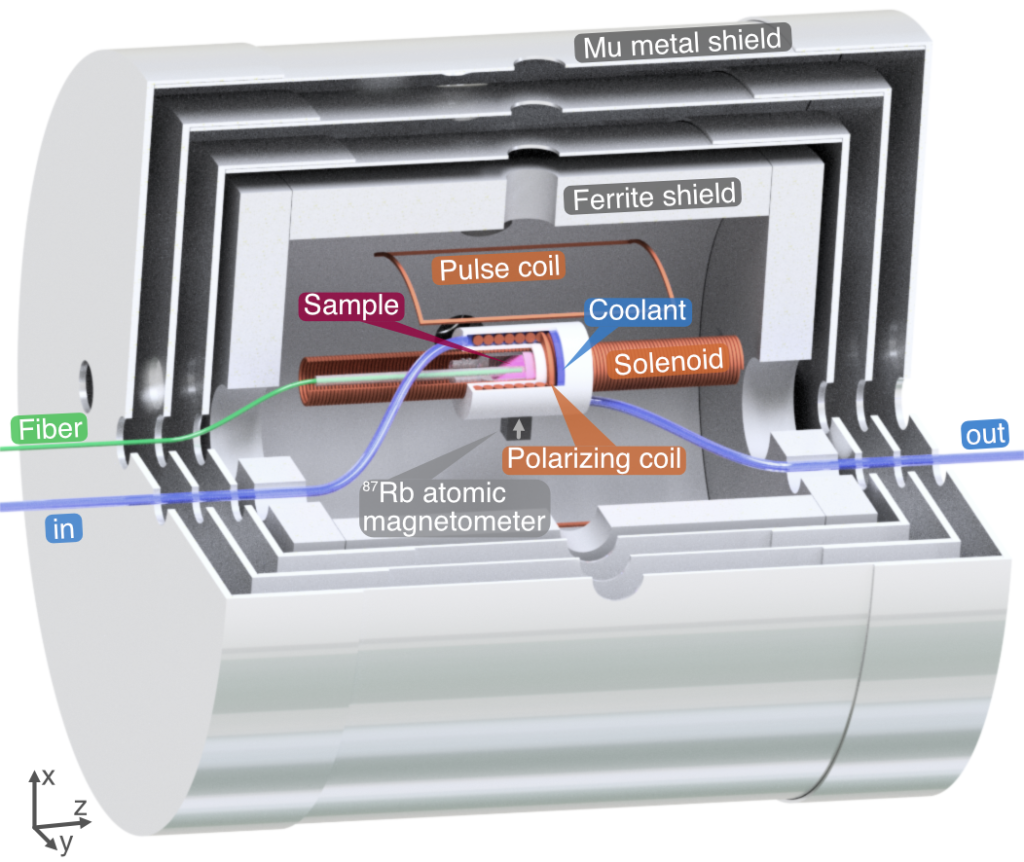
Magnetometer-Detected Nuclear Magnetic Resonance of Photochemically Hyperpolarized Molecules
This paper explores the use of photochemically induced dynamic nuclear polarization (photo-CIDNP) in nuclear magnetic resonance (NMR) measurements at low magnetic fields. By combining shielded fast-field-cycling NMR with atomic magnetometer detection, we achieve in situ low-field photo-CIDNP measurements. Using tetraphenyl porphyrin and 1,4-benzoquinone as a model system, we detect hyperpolarized 1H magnetization at fields as low as 170 nT and 2 μT, with NMR linewidths significantly narrower than those observed in high-field NMR. This approach offers high-resolution spectra even in highly inhomogeneous samples and holds potential for studying spin-chemistry processes, including avian magneto sensing.
Journal of Physical Chemistry Letters 2023, 14, 30, 6814–6822, DOI: 10.1021/acs.jpclett.3c01310
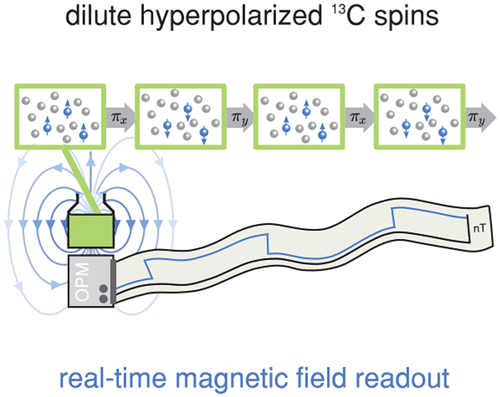
Real-Time Polarimetry of Hyperpolarized 13C Nuclear Spins Using an Atomic Magnetometer
This paper introduces a method for non-destructive quantification of nuclear spin polarization, crucial for hyperpolarized spin tracers in magnetic resonance spectroscopy and imaging. Using a high-sensitivity rubidium vapor magnetometer in a 30 nT bias field, the technique maximizes nuclear spin lifetime and modulates polarization for easy detection. Demonstrated on hyperpolarized [1–13C]-pyruvate, the method offers real-time quality monitoring of hyperpolarized substances and potential applications in hyperpolarized MRI, with future prospects for integrating into clinical quality control and improving in-situ monitoring of polarization buildup.
Journal of Physical Chemistry Letters 2023, 14, 5, 1192–1197, DOI: 10.1021/acs.jpclett.2c03864

Meridional composite pulses for low-field magnetic resonance
This paper presents a method for error-tolerant spin control using nonresonant magnetic-field pulses in low-field nuclear magnetic resonance (NMR). By deriving short sequences of magnetic-field pulses in a meridional plane, we demonstrate robust spin inversion near Earth’s magnetic field, comparable to resonant pulses used in high-field NMR. The study reveals that these meridional pulses offer a unique advantage: they are resilient against variations in both flip angle and axis, a rare feature in high-field composite pulses. This approach has potential applications in sub-MHz NMR spectroscopy, MRI, and portable NMR devices, offering precise spin control without the need for high-frequency circuitry.
Physical Review A 2022, 106, 033102, DOI: 10.1103/PhysRevA.106.033102

Miniature Biplanar Coils for Alkali-Metal-Vapor Magnetometry
This paper discusses the design and application of miniature coils for localized magnetic field control around atomic spin sensors. These sensors, known for their precision in compact microfabricated packages, can benefit significantly from enhanced magnetic field management. By designing coils on biplanar surfaces using a stream-function approach and fabricating them with standard printed-circuit techniques, the study demonstrates improved sensor performance. The paper specifically highlights a coil set optimized for magnetoencephalography (MEG), achieving over 96% field homogeneity within the target volume. This approach could advance the use of optically pumped magnetometers (OPMs) in various high-precision applications, including MEG, where sensor arrays must operate closely together without interference.
Physical Review Applied 2022, 18, 014036, DOI: 10.1103/PhysRevApplied.18.014036
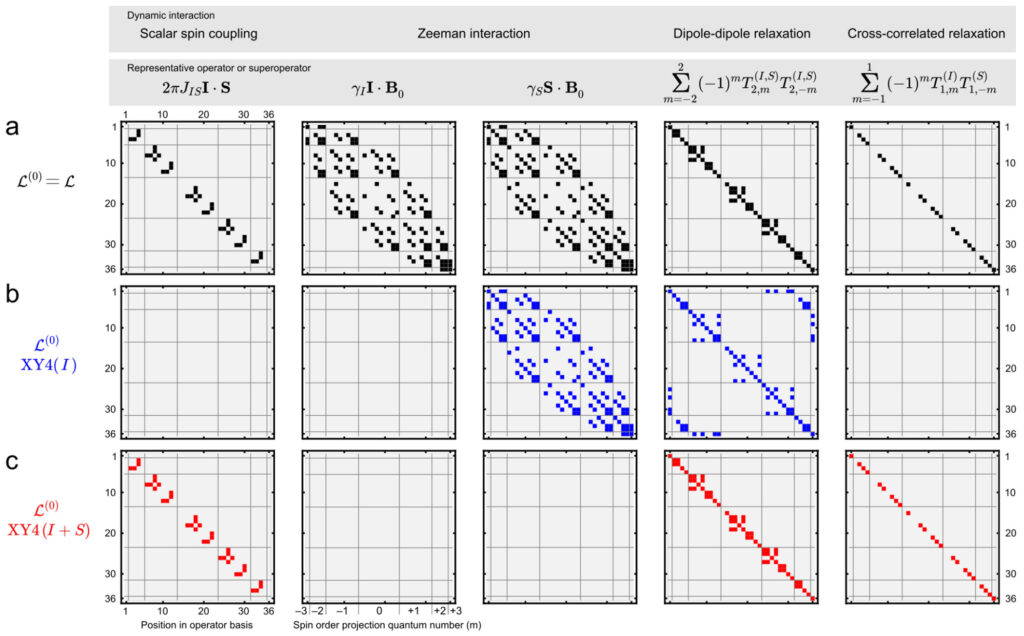
Decoupling of Spin Decoherence Paths near Zero Magnetic Field
This paper presents a method to quantify and manipulate nuclear spin decoherence mechanisms in zero to ultralow magnetic fields. The study identifies key factors, such as nonadiabatic switching of the spin quantization axis and scalar relaxation pathways due to through-bond couplings between 1H and heteronuclear spins like 2H. These factors can limit nuclear spin polarization lifetimes, affecting magnetic resonance techniques near zero field. By implementing robust π-pulse trains and phase cycling techniques, the method enables symmetry switching in the nuclear spin Hamiltonian, allowing for controlled dynamic regimes. This approach has potential applications in enhancing hyperpolarized biomedical contrast agents and improving polarization procedures near zero field.
Journal of Physical Chemistry Letters 2022, 13, 1, 98–104, DOI: 10.1021/acs.jpclett.1c03714
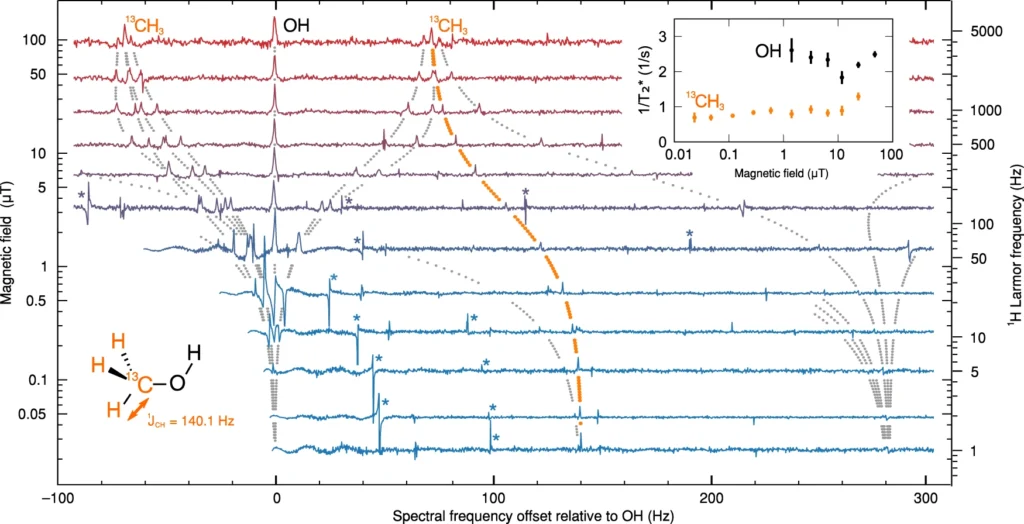
Fast-field-cycling ultralow-field nuclear magnetic relaxation dispersion
Here we explore the application of optically pumped magnetometers (OPMs) in nuclear magnetic relaxation (NMR) measurements. By combining OPMs with fast-field-cycling and high-resolution spectroscopic detection, we reveal critical insights into molecular motion and relaxation mechanisms in liquids. This technique allows for the probing of extremely slow molecular dynamics and the resolution of complex spin-spin couplings in various chemical systems. While the method has current limitations, it offers promising potential for expanding NMR studies, especially in environments where traditional high-field NMR faces challenges.
Nature Communications 2021, 12, 4041, DOI: 10.1038/s41467-021-24248-9
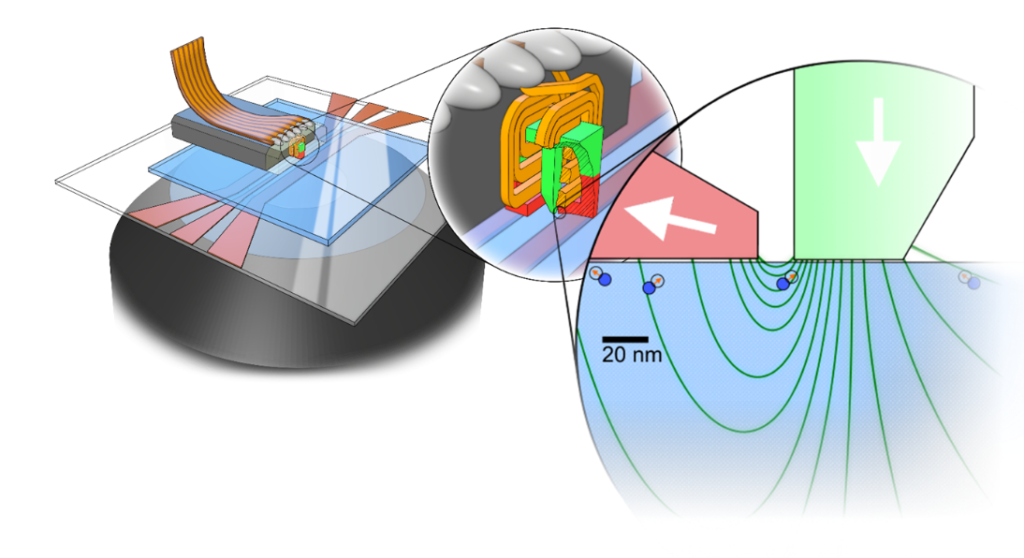
Illustration by Ingmar Jakobi
Measuring nanoscale magnetic write head fields using a hybrid quantum register
Here we demonstrate a method for generating and controlling nanoscale magnetic fields, addressing a critical need in material science and various advanced technologies. Our research demonstrates the use of a hard disc drive write head to achieve precise, coherent control of both single electron and nuclear spins. This allows us to measure magnetic fields with nanoscale spatial resolution and large bandwidth, achieving gradients as high as 10 mT/nm. Our technique enables the characterization of magnetic fields with arbitrary orientation, offering a powerful tool for advancing nanoscale magnetic resonance imaging, quantum spintronics, and the miniaturization of future devices.
Nano Letters 2018, 18, 9, 5389–5395, DOI: 10.1021/acs.nanolett.8b01387
Outreach and Conferences
This section features some of my outreach activities and conference contributions.
YOUNG ATOM OPTICIANS CONFERENCE 2023
I co-organized the Young Atom Opticians (YAO) 2023 conference, held in Barcelona at ICFO. This annual event is tailored for young PhD and master’s students in atomic and molecular physics, offering a platform to learn from leading experts and connect with peers from around the world.
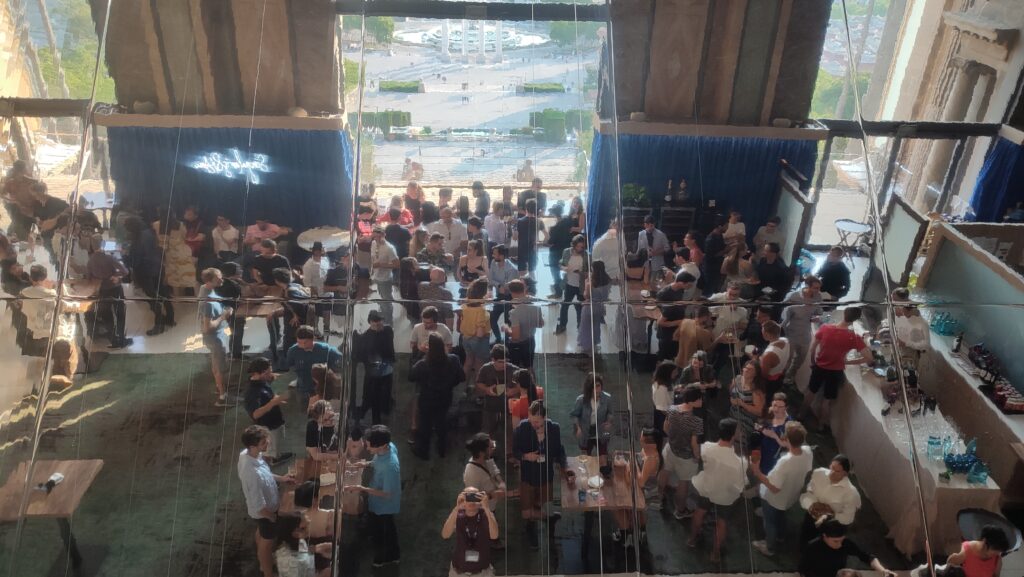
macQsimal
In 2022, I participated in an outreach video for the macQsimal project, which aimed to develop advanced quantum sensors using atomic vapor cells and MEMS technology. Working alongside a diverse European team, we focused on pushing sensor performance to new limits as part of the Quantum Flagship initiative.
μWorkshop on Optically Pumped Magnetometry 2020
In 2020, I co-organized the μ-Workshop on Optically Pumped Magnetometry (μWOPM) as a response to the postponement of WOPM 2020 and Biomag 2020 due to the Corona crisis. Held as a concise, two-day event, μWOPM focused on showcasing novel concepts and visionary ideas in the field. Targeting primarily PhD students, the workshop featured two sessions with six talks each.
ZULF2020 Conference
As the curator of the ZULF ITN YouTube channel, I was responsible for editing the recordings from the 1st Conference on Zero and Ultra Low Field (ZULF) NMR, held online from September 1-4, 2020. Organized by students of the European Training Network ZULF, this conference brought together students, postdocs, and experts in NMR spectroscopy and imaging to explore the emerging field of ZULF NMR. The event began with lectures covering the fundamentals of ZULF NMR, followed by presentations on the latest advancements in the field, delivered by leading researchers.
Workshop on Optically Pumped Magnetometry 2019
In this talk from the Workshop on Optically Pumped Magnetometry 2019, held in August at the Helmholtz Institute in Mainz, I discussed “Wide Field Range Studies of Nuclear Magnetic Relaxation Using Optically Pumped Magnetometers.” I explained how SERF alkali-vapor magnetometers can be used in the zero to ultralow field (ZULF) regime to achieve high-resolution NMR spectra, providing new chemical and physical insights. I also introduced methods to extend ZULF NMR to study multi-phase materials, including challenging samples like liquids in porous materials and metals.
Q-Science Slam 2018
In February 2018, I participated in the first Q-Science Slam at the Theaterhaus Stuttgart, an annual event where young scientists present their research to the general public. Organized by the Center for Integrated Quantum Science and Technology (IQST), the event showcases advances in quantum physics. I won second prize for my talk, “Mit Diamant zu kleineren Festplatten” (Using Diamonds for Smaller Hard Drives). Below is a video from this year’s event.
Selection of other conference contributions
Flash Talk, European Magnetic Resonance (EUROMAR) Conference, Glasgow (UK), 2023
Talk, Symposium GERMN-junior, Madrid (ES), 2023
Talk, Experimental Nuclear Magnetic Resonance Conference (ENC), Orlando (USA), 2022
Talk, Practical Applications of NMR in Industry Conference (PANIC), Nashville (USA), 2021 (online)
Talk, European Magnetic Resonance / International Society of Magnetic Resonance (EUROMAR) Conference, Berlin (GER), 2019
Talk, Workshop on Optically Pumped Magnetometers (WOPM), Mainz (GER), 2019
Theses
This section features my PhD, Master’s and Bachelor’s thesis.
PhD Thesis
This thesis, titled “Optically Detected Nuclear Magnetic Resonance Above and Far Below Earth’s Magnetic Field,” summarizes my PhD research at The Institute of Photonic Sciences (ICFO). Supervised by Professor Morgan Mitchell and Dr. Michael Tayler, the work explores advanced optical magnetometry and low-field magnetic resonance.
Reviewed by Professor Malcolm Levitt (University of Southampton), Professor Karen Sauer (George Mason University), and Professor F. Pelayo García de Arquer (ICFO), it covers studies on spin dynamics, the development of NMRduino hardware and software, and data analysis techniques.

Cover by Thomas Charles
Master’s Thesis
This thesis, titled “Nanoscale Thermometry of a Prototype Hard Disk Head,” presents research from my master’s degree under Professor Jörg Wrachtrup at the 3rd Physics Institute and the Center for Integrated Quantum Science and Technology (IQST). Conducted in collaboration with Seagate Technology, the study investigates new methods for measuring both temperature and magnetic fields at the nanoscale in hard disk drive prototypes.
The research was honored with the inaugural Quantum Futur Award from the Federal Ministry of Education and Research (BMBF) for its contributions to the field.
Bachelor’s Thesis
This thesis, titled “Modulation Spectroscopy of Rydberg Excitons,” presents research conducted from my bachelor’s degree under the guidance of Professor Harald Giessen at the 4th Physics Institute. The focus is on the generation and study of highly excited Rydberg excitons in the semiconductor cuprous oxide (Cu2O).